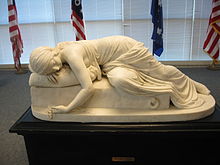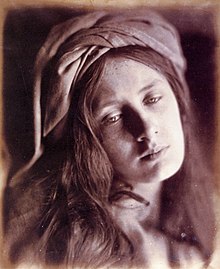Beatrice Cenci
This article's tone or style may not reflect the encyclopedic tone used on Wikipedia. (September 2016) |
Beatrice Cenci (Italian: [beaˈtriːtʃe ˈtʃɛntʃi]; 6 February 1577 – 11 September 1599)[2] was a young Roman noblewoman who murdered her abusive father, Count Francesco Cenci. The subsequent, lurid murder trial in Rome gave rise to an enduring legend about her. She was condemned and beheaded for the crime in 1599.
History[]
Beatrice was the daughter[3] of Ersilia Santacroce and Count Francesco Cenci, a violent and dissolute man. When Beatrice was seven years old, her mother died (June 1584). After her mother's death, Beatrice and her elder sister Antonina were sent to a small monastery, Santa Croce a Montecitorio for Franciscan Tertiary nuns in the Colonna district of Rome.[4]
The family lived in Rome at the Palazzo Cenci in the rione Regola. The members of the extended family living together included Count Francesco's second wife, Lucrezia Petroni; Beatrice's elder brother, Giacomo; and Bernardo, Francesco's son from his second marriage. They also possessed a castle, La Rocca of Petrella Salto, a small village in the Abruzzi mountains northeast of Rome.
According to historical details leading to the legend, Francesco Cenci abused his first wife Ersilia Santa Croce and his sons and raped Beatrice multiple times, thus being guilty of incest. He was jailed for other crimes. But due to his noble status,[5] he was freed early. Beatrice tried to inform the authorities about the frequent mistreatment, but nothing happened, although many in Rome knew what kind of person her father was.[5] When he found out that his daughter had reported him, he sent Beatrice and Lucrezia away from Rome to live in the family's castle at La Petrella del Salto.
The four Cencis decided they had no alternative, but to try to get rid of Count Francesco, and together organized a plot. In 1598, during one of Francesco's stays at the castle, two vassals (one of whom had become Beatrice's secret lover) helped them to drug him, but this failed to kill Francesco. Following this, Beatrice, her siblings, and their stepmother bludgeoned Francesco to death with a hammer and threw the body off a balcony to make it look like an accident. However, no one believed his death to be accidental.
Eventually, his absence was noticed, and the papal police tried to find out what happened. Beatrice's lover was tortured and died without revealing the truth. Meanwhile, a family friend who was aware of the murder ordered the killing of the second vassal to avoid any risk. Nonetheless, the plot was discovered, and the four members of the Cenci family were arrested, found guilty, and sentenced to death. Knowing the reasons for the murder, the common people of Rome protested against the tribunal's decision, obtaining a short postponement of the execution. Pope Clement VIII; however, fearing a spate of familial murders (the Countess of Santa Croce had recently been murdered by her son for financial gain), showed no mercy.
At dawn on 11 September 1599, they were taken to Sant'Angelo Bridge, where the scaffold was usually built. In the cart to the scaffold, Giacomo was subjected to continual torture. On reaching the scaffold, his head was smashed with a mallet. His corpse was then quartered. The public spectacle continued with the executions of first Lucrezia and finally Beatrice. Both took their turns on the block to be beheaded with a small axe. Only the 12-year-old, Bernardo, was spared, but he was led to the scaffold and forced to witness the execution of his relatives before returning to prison and having his properties confiscated (to be given to the Pope's own family). It was decreed that Bernardo should then become a galley slave for the remainder of his life.[6] However, he was released a year later. Beatrice was buried in the church of San Pietro in Montorio.
The legend[]
Beatrice has become a symbol to the people of Rome of resistance against the arrogant aristocracy, and a legend arose. It is related that every year on the night before the anniversary of her death, she comes back to the bridge where she was executed, carrying her severed head.
Influence on literature and the arts[]


Beatrice Cenci has been the subject of a number of literary and musical works:
- Philip Massinger's play The Unnatural Combat (c.1619) contains specific echoes of the case and antedates the Romantic revival of Beatrice by 200 years
- Percy Bysshe Shelley's verse drama The Cenci: A Tragedy in Five Acts (composed at Rome and at Villa Valsovano near Livorno, May–5 August 1819, published spring 1820 by C. & J. Ollier, London, 1819)
- "Les Cenci", a short story by Stendhal (1837)
- Béatrix Cenci, a verse drama (1839), by Polish poet, Juliusz Słowacki
- Beatrice Cenci, a novel by Francesco Domenico Guerrazzi (1854)
- "Beatrice Cenci (In a City Shop-Window)", (1871) a poem by Sarah Piatt, American poet
- Béatrix Cenci, by Astolphe de Custine
- Nemesis, tragedy by Alfred Nobel
- Beatrice Cenci, a play by Alberto Moravia
- Beatriz Cenci, a verse drama by Gonçalves Dias
- Beatrix Cenci, opera by Alberto Ginastera, based on the Shelley play
- Beatrice Cenci, opera by Berthold Goldschmidt, based on the Shelley play
- Les Cenci (1935), play by Antonin Artaud, adaptation of the Shelley play
- The Cenci, essay by Alexandre Dumas in Volume 1 of Celebrated Crimes (1840)
- Legende und Wahrheit der Beatrice Cenci (1926), short story by Stefan Zweig
- The Cenci (1951–52), an opera by Havergal Brian (abridged from Shelley's play)
- The Cenci Family (2004), a radio play by Lizzie Hopley directed by Lu Kemp
- Beatrice Cenci (2006), musical drama by Alessandro Londei and Brunella Caronti
- Béatrice Cenci : Telle une fleur coupée, a novel by Jean Rocchi, editor Esmeralda (10 May 2004)
- "Finis the Cenci" (1954), a 17-line poem by F. R. Scott in Events and Signals; also in his Selected Poems (1966) and Collected Poems (1981)
- A Tale for Midnight (1955), a novel by Frederic Prokosch
- the Canadian opera Beatrice Chancy, written by George Elliott Clarke and James Rolfe (and inspired by the Shelley play), transplants the story to nineteenth-century Nova Scotia.
- 11 settembre 1599, A Beatrice Cenci , a piece in poetic prose by Sabrina Gatti (Italian writer), in Il trono dei poveri (2020)
Statues, paintings, and photography also provide numerous portraits and homages to Beatice Cenci: The Italian painter Caravaggio witnessed Beatrice's public execution and may have used it as inspiration for the decapitation scene in his painting Judith Beheading Holofernes.[7]
A statue by American sculptor Harriet Goodhue Hosmer entitled Beatrice Cenci (1857) is on display at the Art Gallery of New South Wales, Australia, as part of their permanent collection.

The early photographer Julia Margaret Cameron posed her model, May Prinsep, as Beatrice in an 1866 albumen print portrait among a series she devoted to Beatrice Cenci.
The painting of Beatrice Cenci by Baroque painter Guido Reni (1575–1642) and the legend surrounding Beatrice figure prominently in Nathaniel Hawthorne's The Marble Faun (1860). The book's two principal female characters, Hilda and Miriam, debate the nature and extent of Beatrice's guilt. Hilda believes Beatrice's act to be an "inexpiable crime" but Miriam believes it was "no sin at all, but the best possible virtue in the circumstances". Hawthorne draws many similarities between Miriam and Beatrice, and the reader must decide whether Miriam is an avenger or a culprit.
In Letitia Elizabeth Landon's short story "The Bride of Lindorf" (1836), the main character has an emotional attachment to the painting of Beatrice Cenci.
The Reni painting and the story of Beatrice figure in the plot of Liza Marklund's novel Last Will (2006). The painting also figures in Book 26 of Herman Melville's novel Pierre; or, The Ambiguities (1852).
Films have been inspired by the life of Beatrice Cenci also:
In David Lynch's film Mulholland Dr. (2001), Reni's painting is shown hanging in the Hollywood apartment of Ruth Elms as a reference to Cenci.
The 1969 Italian film Beatrice Cenci, directed by Lucio Fulci, follows the historical events of her life very closely. Fulci claimed it was one of his favorite works, though he was better known for his gruesome horror films. It was also distributed under the title The Conspiracy of Torture.
The character played by Mia Farrow in the film Secret Ceremony is named Cenci, in reference to the Beatrice legend.
See also[]
| Wikimedia Commons has media related to Beatrice Cenci. |
- Tochigi patricide case
- List of people executed by the Holy See
Notes[]
References[]
- ^ Jump up to: a b Nicholl (1998).
- ^ "Beatrice Cenci | Italian noble". Encyclopedia Britannica. Retrieved 25 April 2019.
- ^ "See C. Ricci in the entry "Cenci"". Encyclopedia Italiana. treccani.it. 1931. Retrieved 20 June 2017.
- ^ Mariano Armellini. Le chiese di Roma Dalle loro origini sino al secolo XVI. Roma, Tipografia Editrice Romana, 1887, page 214.
- ^ Jump up to: a b Naish, Camille, 1945- (2013). Death comes to the maiden sex and execution 1431-1933. London: Routledge. p. 67. ISBN 9780203104019. OCLC 1059033365.CS1 maint: multiple names: authors list (link)
- ^ bart.), George Bowyer (sir, 7th; Farinaccius, Prosper (1838). A dissertation on the statutes of the cities of Italy; and a translation of the pleading of Prospero Farinacio in defence of Beatrice Cenci. Richards and Co.
- ^ Robb, Peter (1998). "M: The Caravaggio Enigma". Duffy and Snellgrove. Missing or empty
|url=(help)
Bibliography[]
- Chisholm, Hugh, ed. (1911). . Encyclopædia Britannica. 5 (11th ed.). Cambridge University Press. pp. 660–661.
- Guarazzi, Francesco Domenico, Beatrice Cenci. (in Italian)
- Nicholl, Charles (2 July 1998), "Screaming in the Castle: The Case of Beatrice Cenci", London Review of Books, Vol. XX, No. 13, pp. 23��7.
- 1577 births
- 1599 deaths
- 16th-century Italian women
- Nobility from Rome
- People executed for murder
- Executed Italian people
- Italian female murderers
- 16th-century executions by Italian states
- Executed Italian women
- People executed by the Papal States by decapitation
- Italian people convicted of murder
- People convicted of murder by Italy
- Patricides
- Criminals from Rome
